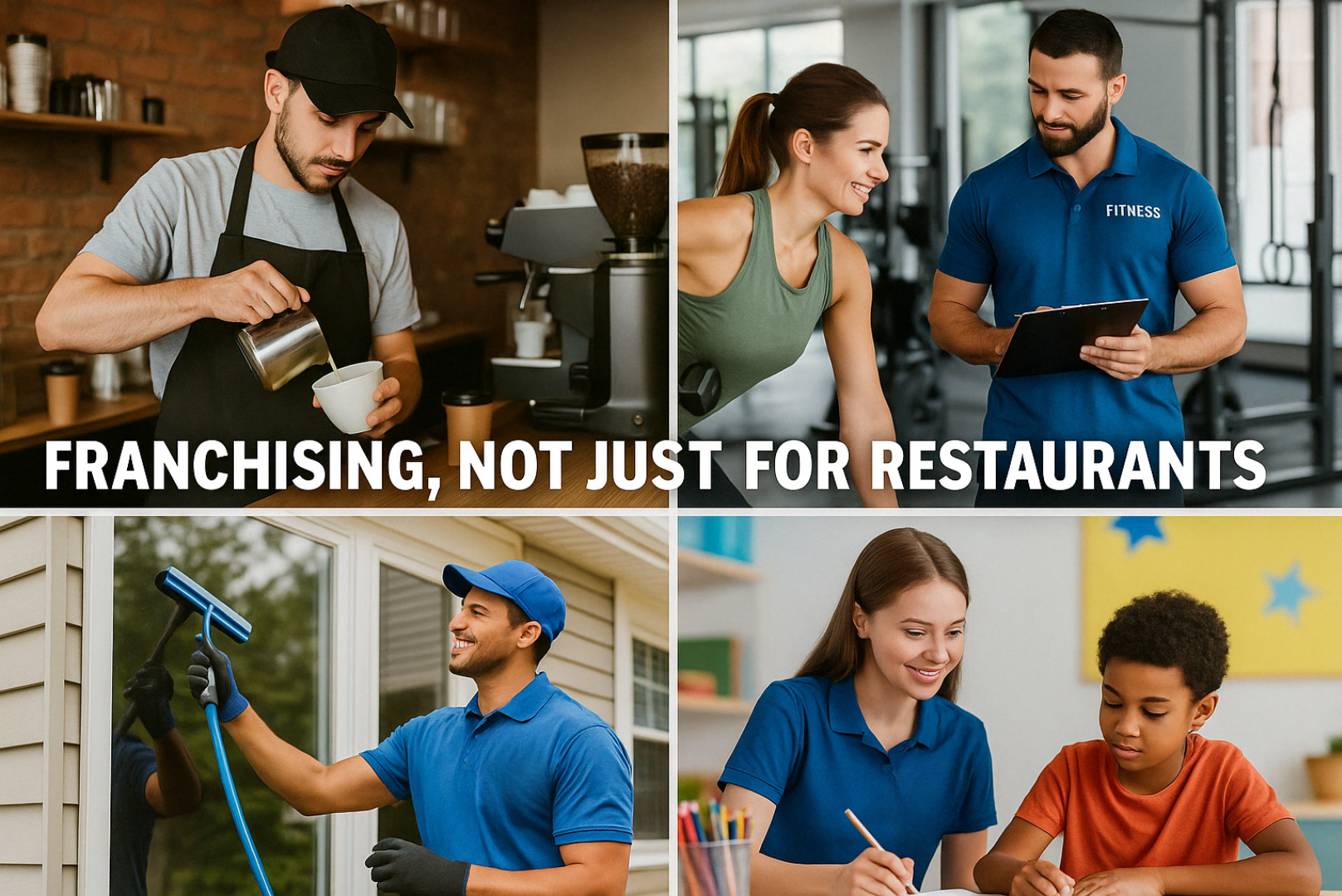As of July 27, 2025, surging consumer sentiment now at 61.8 has ignited growth across the restaurant franchise sector. Operators are seeing same store sales rise by 2.0 percent, benefiting from easing inflation, resilient consumer spending, and strategic tariff management. These factors have combined to create a powerful foundation for franchise growth and record-breaking food industry profits.
RESTAURANT FRANCHISE BOOM: SOARING CONSUMER SENTIMENT AND SMART TARIFF STRATEGY FUEL U.S. DINING GROWTH. REPORT JULY 2025
By Gary Occhiogrosso, Founder, Franchise Growth Solutions

| Franchise My Business | Franchise Growth Solutions Whether you’re looking to expand a current franchise or start franchising your business, Franchise Growth Solutions has an expert team to support you. www.frangrow.com |
As of July 27, 2025, the U.S. consumer sentiment recovery is a linchpin in the ongoing strength of the restaurant industry. With inflation easing, costs of goods falling, and Wall Street at all‑time highs, consumer appetite for dining out is fueling upward momentum for restaurant operators and franchisees.
- Consumer Confidence Rebound Clears the Path for Franchise Expansion
The University of Michigan’s Consumer Sentiment Index climbed to 61.8 in July 2025, up from 60.7 in June, signaling renewed optimism among U.S. consumers.
Further, 12 month inflation expectations fell to 4.4 percent, while long term expectations eased to 3.6 percent, their lowest levels since February 2025.
For restaurant franchises, this rebound is pivotal. Positive consumer sentiment translates into increased discretionary spending, stronger foot traffic, and higher average check sizes, laying the groundwork for aggressive unit growth in the second half of the year.
- Restaurant Franchise Growth Fueled by Same Store Sales Momentum
According to Black Box Intelligence, same store sales increased by 2.0 percent in June 2025, marking the strongest monthly performance since January. Although traffic dipped slightly by 0.9 percent, improved guest spend more than offset the slowdown.
A report from the National Restaurant Association supports this trend, revealing that 49 percent of restaurant operators experienced higher same store sales year over year in June, compared with just 36 percent reporting improved traffic.
For franchise owners, these numbers mean higher per unit revenue, healthier margins, and an attractive financial model for scaling operations.
- Inflation Rate in 2025 Cooling and Supporting Profits
The inflation rate 2025 shows steady cooling. Recent consumer price index data indicates that year over year price growth slowed to 2.4 percent, with monthly increases limited to 0.1 percent .
For restaurant operators, particularly franchisees, lower inflation means better control over food costs, operational expenses, and menu pricing. This environment provides room to preserve profitability while offering value-driven promotions that strengthen competitive positioning.
- Tariff Impact Transformed into Strategic Advantage
Although tariffs remain higher than in previous years, their impact on consumer spending has been far less disruptive than predicted. After peaking near 27 percent in early 2025, average effective tariff rates eased to around 15.8 percent by June.
Budget Lab data shows that tariffs have increased consumer prices by an estimated 2.3 percent, costing the average household $3,800 in purchasing power but generating $3.1 trillion in federal revenue.
Rather than hurting sales, many restaurant franchises have absorbed the incremental costs. Chipotle, for example, announced it would manage tariff-related increases internally to maintain its value proposition.
Strong operational scale, efficient supply chain strategies, and loyalty driven pricing have turned potential tariff challenges into a franchise advantage.
- Promotions, Takeout Trends, and In Store Experience Innovations
Value promotions are driving success for franchises:
McDonald’s cut combo meal prices by approximately 15 percent, positioning itself as a value leader. Taco Bell introduced Luxe Cravings Boxes priced between $5 and $9, achieving record sell-through rates.
Chili’s “3 for Me” campaign boosted same store sales by 31 percent.
Applebee’s leveraged its “2 for $25” menu to achieve a 4.9 percent same store sales increase in Q2 2025.
Simultaneously, top restaurant brands are improving in store experiences to reconnect with customers seeking comfort, quality, and community: Starbucks reintroduced ceramic mugs and warmer interiors.Cava enhanced design aesthetics, adding greenery and better lighting.Dave and Buster’s invested in immersive entertainment features to elevate experiential dining.
For franchises, these moves address takeout trends while enhancing loyalty and boosting long term profitability.
- Consumer Spending Stays Resilient
Despite widespread reports that consumers are “cutting back,” data reveals the opposite. A recent Business Insider study found that restaurant spending rose 2.1 percent between March and June 2025, compared with just a 0.1 percent increase for grocery spending.
Consumers are clearly prioritizing experiential dining and convenience, reinforcing the durability of the restaurant franchise model.
- The Franchise Outlook for the Second Half of 2025
All indicators point to a strong second half for restaurant franchises:
Consumer sentiment at 61.8 supports continued spending growth.Same store sales momentum and innovative promotions are improving per unit performance.
Inflation control is lowering cost pressures, supporting reinvestment.Tariffs are being managed proactively, minimizing consumer impact.Takeout and loyalty infrastructure continues to dominate, aligning with evolving consumer expectations.
Franchises that embrace value, innovate guest experiences, and scale strategically are positioned to outperform independents and capitalize on franchise growth opportunities.
- Action Plan for Restaurant Franchise Operators
Leverage Consumer Sentiment Data: Align expansion strategies with regions demonstrating the strongest recovery.
Prioritize Value Bundles and Loyalty Programs: Win traffic without sacrificing margins. Invest in Guest Experience: Enhance in-store aesthetics to complement digital convenience.
Optimize Supply Chains: Use centralized buying power to mitigate tariff and commodity volatility. Target Delivery and Takeout Channels: With 75 percent of restaurant traffic involving off-premises orders, capitalize on infrastructure that supports consumer demand.
Conclusion
July 2025 marks an inflection point for the restaurant franchise industry. Rising consumer confidence, easing inflation, smart tariff strategies, and consistent same store sales growth are creating an environment primed for profitability.
Franchises have proven their ability to weather economic shifts, adapt pricing models, and deliver value at scale. The result is a thriving segment of the U.S. economy, where operators can grow margins, expand units, and increase food industry profits in the months ahead.
News Highlights
- Eating and drinking place sales up 5.6% year over year in July; small monthly dip. NRA+11NRA+11census.gov+11
- Chili’s same store sales up 24% with value menus and TikTok campaigns. com+3The Week+3Times Union+3
- Value promotions across chains driving demand. Times Union+1
- Ambiance investments at Cava, Starbucks, Dave & Buster’s. MarketWatch+2restaurantdive.com+2
- High‑income consumer spending rising in July. Yahoo Finance+3MarketWatch+3NRA+3
Verified Sources and Websites
| Website | ||
| Consumer Sentiment and Inflation Expectations | Reuters | https://www.reuters.com |
| Same Store Sales Growth | Black Box Intelligence | https://blackboxintelligence.com |
| CPI Inflation Data | Bureau of Labor Statistics | https://www.bls.gov |
| Restaurant Spending Trends | Business Insider | https://www.businessinsider.com |
| Tariff Impact and Resilience | Budget Lab, Yale | https://budgetlab.yale.edu |
| Promotions and Takeout Value | Times Union | https://www.timesunion.com |
| In Store Experience Innovation | MarketWatch | https://www.marketwatch.com |
| Off Premises Dining Trends | Food & Wine, NRA Report | https://www.foodandwine.com |
Key Stats Summary
| Indicator | Value / Change |
| Consumer Confidence (Conference Board) | 93 in June with modest July rebound |
| Inflation Expectation (12‑mo) | 4.4% (down from 5.0%) |
| Long-run Inflation Expectation | 3.6% (lowest since Feb ’25) |
| Retail Sales (June) | +0.6%, including restaurants |
| Unemployment Rate | 4.2%, historically low |
| Tariff Incidence (on consumers) | 49% of tariff cost passed to consumers |
| Imported good price rise | 3% March‑July |
| Chipotle same-store sales | – 4% in Q2 |
| McDonald’s same-store U.S. sales | – 3.6% in Q1 S&P 500 & Nasdaq at record highs |
This article was researched, outlined and edited with the support of A.I.




